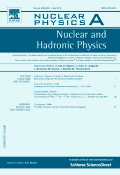
NUCLEAR PHYSICS A
Scope & Guideline
Connecting Theory and Practice in Nuclear Physics
Introduction
Aims and Scopes
- Nuclear Structure and Dynamics:
Research focusing on the properties and behaviors of atomic nuclei, including studies on shape coexistence, nuclear decay modes, and the mechanisms of nuclear reactions. - Astrophysical Nuclear Processes:
Investigations into nuclear reactions and processes that play a critical role in astrophysical contexts, such as nucleosynthesis in stars, neutron star physics, and interactions involving exotic nuclei. - Quantum Field Theoretical Approaches:
Application of quantum field theory to nuclear interactions, exploring concepts such as quantum chromodynamics (QCD), effective field theories, and the use of advanced computational techniques. - Heavy-Ion Collisions:
Studies involving high-energy collisions of heavy ions to investigate the properties of nuclear matter under extreme conditions, such as those found in neutron stars or during the early universe. - Exotic Nuclei and Nuclear Models:
Research on nuclei beyond the stability line, including studies on halo nuclei, cluster structures, and the development of theoretical models to describe these exotic configurations. - Nuclear Reactions and Cross-Section Measurements:
Experimental and theoretical analyses of nuclear reactions, including detailed measurements of reaction cross-sections, decay processes, and the underlying mechanisms driving these phenomena.
Trending and Emerging
- Nuclear Astrophysics:
There is a growing trend in exploring nuclear processes relevant to astrophysics, particularly in understanding nucleosynthesis and the role of nuclear reactions in stellar evolution and supernovae. - Quantum Computing Applications:
Emerging studies are beginning to utilize quantum computing techniques to solve complex nuclear physics problems, indicating a trend towards leveraging advanced computational methods for theoretical advancements. - Machine Learning in Nuclear Physics:
The application of machine learning techniques for analyzing data, predicting outcomes, and optimizing experimental designs is becoming increasingly prevalent, marking a significant shift in how research is conducted. - Exotic Hadron Physics and Pentaquarks:
Research into exotic states of matter, such as pentaquarks and other multi-quark systems, is on the rise, reflecting an expanding interest in understanding the complexities of strong interactions. - Nuclear Matter under Extreme Conditions:
Recent publications are increasingly focused on studying the properties of nuclear matter under extreme conditions, such as high temperature and density, particularly relevant to heavy-ion collision experiments.
Declining or Waning
- Traditional Nuclear Models:
There appears to be a decrease in publications relying solely on traditional nuclear models without incorporating newer theoretical frameworks or computational techniques, suggesting a shift towards more innovative approaches. - Low-Energy Nuclear Reactions:
Research on low-energy nuclear reactions has diminished, possibly due to a growing emphasis on high-energy and astrophysical processes that yield more significant insights into fundamental nuclear behavior. - Basic Nuclear Properties Measurements:
The focus on routine measurements of basic nuclear properties, such as binding energies and simple decay modes, is declining as researchers increasingly prioritize complex phenomena or exotic nuclei.
Similar Journals
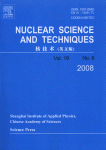
Nuclear Science and Techniques
Pioneering Research for a Sustainable Nuclear FutureNuclear Science and Techniques is a distinguished peer-reviewed journal published by Springer Singapore Pte Ltd, dedicated to advancing the fields of nuclear science and engineering. With an impressive impact factor reflected in its 2023 quartile rankings—Q2 in Nuclear and High Energy Physics and Q1 in Nuclear Energy and Engineering—the journal serves as a vital resource for researchers, professionals, and students alike. Covering a breadth of topics from nuclear physics to energy applications, it offers a platform for innovative research and developments in the nuclear domain. The journal, indexed under ISSN 1001-8042 and E-ISSN 2210-3147, aims to foster scientific exchange and collaboration within the community by publishing high-quality articles that contribute significantly to the field. Committed to maintaining an open-access ethos, it enhances visibility and accessibility of critical knowledge, making it an essential source for current insights and trends in nuclear science.
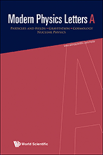
MODERN PHYSICS LETTERS A
Exploring the Depths of Astrophysics and Nuclear PhysicsMODERN PHYSICS LETTERS A, published by World Scientific Publishing Co Pte Ltd, is a distinguished journal in the field of physics that serves as a pivotal platform for researchers, professionals, and students alike. With ISSN 0217-7323 and E-ISSN 1793-6632, the journal has gained international acclaim for its contributions to Astronomy and Astrophysics as well as Nuclear and High Energy Physics. The journal is ranked in Q3 for both Astronomy and Astrophysics and Nuclear and High Energy Physics, showcasing its relevance in these areas, while also achieving a Q2 ranking in the broader category of Physics and Astronomy (miscellaneous). Spanning from 1996 to 2024, MODERN PHYSICS LETTERS A promotes open dialogue and dissemination of pioneering research findings and innovative theories. While the journal operates without an open access option, its rich content is easily accessible through various academic databases, ensuring that vital research is shared widely among the scientific community. Situated in Singapore, this journal plays an essential role in the continuous advancement of the physics discipline, fostering collaboration and knowledge sharing among global researchers.
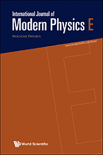
INTERNATIONAL JOURNAL OF MODERN PHYSICS E
Advancing the Frontiers of Nuclear and High Energy PhysicsThe INTERNATIONAL JOURNAL OF MODERN PHYSICS E, published by WORLD SCIENTIFIC PUBL CO PTE LTD, serves as a distinctive platform for the dissemination of high-quality research in the fields of Nuclear and High Energy Physics, as well as Physics and Astronomy. With an ISSN of 0218-3013 and covering a timeline from 1996 to 2024, the journal has established itself within the academic community, achieving a respectable Q3 ranking in its respective categories for 2023, underscoring its commitment to advancing knowledge in modern physics. Although it operates without an open access model, the journal's curated content is accessible to a wide audience of researchers, professionals, and students engaged in cutting-edge physics. Set in Singapore, this journal not only contributes to scholarly discussions but also fosters a global collaboration among physicists, making it an invaluable resource for those seeking to deepen their understanding and contribute to ongoing dialogues in the scientific community.
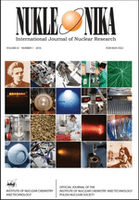
NUKLEONIKA
Connecting Ideas, Inspiring DiscoveriesNUKLEONIKA, published by SCIENDO, is a leading open access journal that has been serving the scientific community since its establishment in 1968. Focused on the domains of Nuclear and High Energy Physics, Condensed Matter Physics, and Nuclear Energy and Engineering, this journal provides a platform for innovative research and technological advancements in a variety of interdisciplinary fields. With an impressive history of publications and a current Q3 ranking in several categories, including Safety, Risk, Reliability and Quality and Waste Management and Disposal, NUKLEONIKA is recognized for its significant contributions to scientific discourse. Open access since 2014, the journal ensures that all research outputs are freely available, facilitating broad dissemination and accessibility for researchers, professionals, and students alike. Located in the heart of Warsaw, Poland, NUKLEONIKA aims to inspire collaborative efforts and foster a deeper understanding of complex physical phenomena and their practical implications.
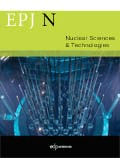
EPJ Nuclear Sciences & Technologies
Exploring the Future of Nuclear Science and EngineeringEPJ Nuclear Sciences & Technologies is a prominent Open Access journal published by EDP Sciences S A, focusing on the vital fields of Nuclear and High Energy Physics, Nuclear Energy and Engineering, and Energy Engineering and Power Technology. Launched in 2015, this journal provides a platform for researchers, students, and professionals to disseminate cutting-edge research and innovations that address the challenges and opportunities in nuclear sciences, a field of critical importance in today’s energy landscape. With an ISSN of 2491-9292 and an evolving impact reflected in its 2023 Q3 quartile rankings across several relevant categories, EPJ Nuclear Sciences & Technologies is committed to promoting high-quality, peer-reviewed research accessible to a global audience. Its dedicated focus on enhancing knowledge transfer and international collaboration makes it an essential resource for anyone engaged in nuclear sciences and technologies.
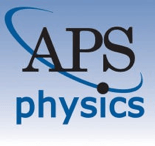
PHYSICAL REVIEW C
Exploring the Depths of Nuclear SciencePHYSICAL REVIEW C is an esteemed journal published by the American Physical Society, dedicated to advancing knowledge in the fields of nuclear and high-energy physics. With a proud ISSN of 2469-9985 and an E-ISSN of 2469-9993, it has established itself as a leading journal, currently ranked in the Q1 category for its field in 2023, positioning itself in the top tier of scholarly publications. Based in the heart of the United States, at One Physics Ellipse, College Park, MD, PHYSICAL REVIEW C is known for its rigorous peer-review process and is a vital platform for researchers to share their pioneering findings. As part of a prestigious lineup backed by an impressive impact factor, this journal garners significant attention, reflected in its Scopus ranking as #18 out of 87 in the Nuclear and High Energy Physics category, placing it within the 79th percentile. While it currently does not offer open access options, it remains an essential resource for professionals and students seeking to deepen their understanding of nuclear interactions, reaction dynamics, and the fundamental principles governing subatomic particles. The convergence of innovative research from 2016 to 2024 makes it a timely reservoir for groundbreaking studies, thus reinforcing its importance in the scientific community.

PHYSICS LETTERS A
Accelerating Knowledge in the World of PhysicsPhysics Letters A is a renowned scientific journal published by Elsevier, dedicated to the field of physics and astronomy. Established in 1963, it has continuously evolved, offering a platform for the swift dissemination of significant research findings in various branches of physics. As of 2023, it holds a commendable Q2 ranking in the category of Physics and Astronomy (miscellaneous) and ranks 69th out of 243 journals in the same domain according to Scopus, positioning itself in the 71st percentile of academic impact. With its comprehensive scope, Physics Letters A provides a vital resource for researchers, professionals, and students, facilitating academic discourse and advancing knowledge across the field. Although it does not currently offer Open Access options, its rigorous peer-review process ensures high-quality content. It is centrally located in Amsterdam, Netherlands, and continues to be an essential outlet for innovative contributions to the physics community through the year 2024 and beyond.

EUROPEAN PHYSICAL JOURNAL C
Exploring the Depths of Quantum Field TheoryEUROPEAN PHYSICAL JOURNAL C (EPJ C), published by SPRINGER, stands as a premier platform for innovative research in the domains of Physics and Engineering. With its Open Access policy established in 2014, EPJ C ensures that groundbreaking findings are readily available to the global scientific community, enhancing accessibility and collaboration. The journal, indexed in prestigious databases, boasts an impressive impact factor and ranks within the Q1 category for both Engineering and Physics and Astronomy, placing it among the top-tier journals in these fields. Celebrated for its rigorous peer-review process, EPJ C offers a wide-ranging scope encompassing various topics in particle physics, quantum field theory, and related interdisciplinary studies. Its consistent publication since 1991 has fostered a vibrant community of researchers dedicated to advancing knowledge and innovation in physics and engineering. Join the scholarly discussion and contribute to the cutting-edge research made possible through EPJ C's esteemed platform.

PHYSICS OF PARTICLES AND NUCLEI
Connecting Researchers Through Innovative InsightsPhysics of Particles and Nuclei is an esteemed journal within the field of nuclear and high energy physics, published by Pleiades Publishing Inc. Based in the United States, this journal has been a vital platform for disseminating cutting-edge research since its inception in 1996, with coverage extending until 2024. Indexed under the ISSN 1063-7796 and the E-ISSN 1531-8559, it has established itself as a noteworthy publication, currently categorized in the Q3 quartile according to the 2023 standards for Nuclear and High Energy Physics. With its Scopus ranking placing it at #62 out of 87 in its category, Physics of Particles and Nuclei provides unique insights and discussions that resonate with academics, researchers, and students alike. Although it does not offer open access, the journal continues to serve as a crucial resource for those looking to engage deeply with the latest advancements and theoretical explorations in particle and nuclear physics.

FEW-BODY SYSTEMS
Pioneering Studies in the Realm of Few-Body SystemsFEW-BODY SYSTEMS is a distinguished journal published by Springer Wien, dedicated to advancing the field of Atomic and Molecular Physics and Optics. With an ISSN of 0177-7963 and an E-ISSN of 1432-5411, this scholarly periodical has been a vital resource since its inception in 1986, with a continued commitment to disseminating high-quality research up to 2024. Recognized in the Q2 quartile in its category and ranked 132 out of 224 in Scopus within the relevant fields, FEW-BODY SYSTEMS provides a platform for innovative studies that explore the complexities of few-body quantum systems, fostering discussions that enhance scientific understanding and technological advancement. Based in Vienna, Austria, this journal reflects a global scholarly community's engagement with pressing theoretical and experimental topics, contributing significantly to the ongoing discourse in physics and optics. Although it does not currently offer open access options, it remains a reputable choice for researchers, professionals, and students eager to delve into the intricate dynamics of few-body interactions.